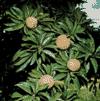- sapodilla
-
/sap'euh dil"euh/, n.1. a large evergreen tree, Manilkara zapota, of tropical America, bearing an edible fruit and yielding chicle. Cf. sapodilla family.2. Also called sapodilla plum. the fruit itself.[1690-1700; < Sp zapotillo, equiv. to zapot(e) SAPOTA + -illo dim. suffix]
* * *
Tropical evergreen tree (Manilkara zapota ) of the family Sapotaceae, native to southern Mexico and northern Central America, and its distinctive fruit.The rusty-brown fruit is eaten fresh in many tropical and subtropical areas. Its sweet flavour has been compared to a combination of pears and brown sugar. When the fruit is ripe, its shiny black seeds are surrounded by clear, yellowish brown, juicy flesh; when immature, its flesh contains both tannin and milky latex and is distasteful. The latex is the chief source of gum chicle, once important in the chewing-gum industry. Sapodilla (Manilkara, or Achras, zapota)Walter Dawn
Sapodilla (Manilkara, or Achras, zapota)Walter Dawn* * *
▪ tree and fruit(species Manilkara zapota, or Achras zapota), tropical evergreen tree of a genus of about 80 species in the family Sapotaceae and its distinctive fruit. Though of no great commercial importance in any part of the world, the sapodilla is much appreciated in many tropical and subtropical areas, where it is eaten fresh. The fruit is spheroid to ovoid in shape, rusty brown on the surface, and roughly 5–10 cm (2–4 inches) in diameter. The sweet flavour has been compared to a combination of pears and brown sugar. When the fruit is ripe the seeds, two to five in number, shiny black, and the size of flattened beans, are surrounded by translucent, yellowish brown, juicy flesh. When the fruit is immature, its flesh contains both tannin and milky latex and is unpalatable. The milky latex, the chief source of gum chicle that was once important in the chewing-gum industry (and once used as chewing gum by the Aztecs), is extracted by tapping the trunk.Sapodilla trees grow wild in the forests of southern Mexico and northern Central America. As a cultivated species the tree is medium-sized and of slow growth. The reddish wood is hard and durable; elaborately carved lintels of sapodilla 1,000 years old are still to be seen in some Mayan ruins. The leaves, 5–12.5 cm (2–5 inches) long, are glossy and light green in colour and ovate to elliptic in outline; the flowers are small and inconspicuous. Propagation is usually by means of seed, but superior trees can be reproduced by grafting.* * *
Universalium. 2010.
